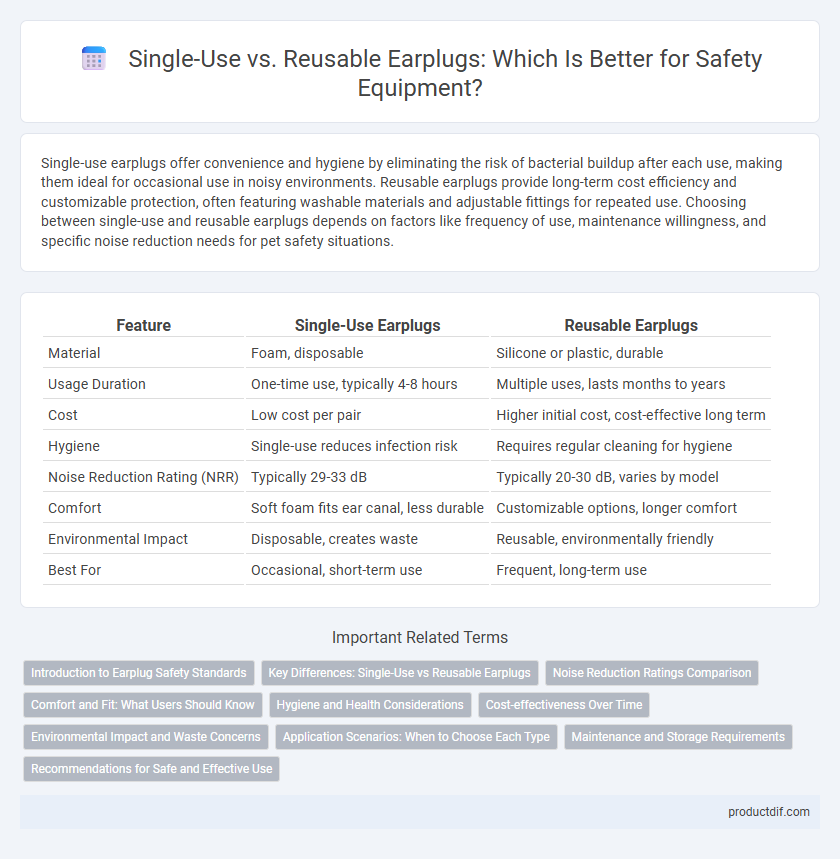Single-use earplugs offer convenience and hygiene by eliminating the risk of bacterial buildup after each use, making them ideal for occasional use in noisy environments. Reusable earplugs provide long-term cost efficiency and customizable protection, often featuring washable materials and adjustable fittings for repeated use. Choosing between single-use and reusable earplugs depends on factors like frequency of use, maintenance willingness, and specific noise reduction needs for pet safety situations.
Table of Comparison
| Feature | Single-Use Earplugs | Reusable Earplugs |
|---|---|---|
| Material | Foam, disposable | Silicone or plastic, durable |
| Usage Duration | One-time use, typically 4-8 hours | Multiple uses, lasts months to years |
| Cost | Low cost per pair | Higher initial cost, cost-effective long term |
| Hygiene | Single-use reduces infection risk | Requires regular cleaning for hygiene |
| Noise Reduction Rating (NRR) | Typically 29-33 dB | Typically 20-30 dB, varies by model |
| Comfort | Soft foam fits ear canal, less durable | Customizable options, longer comfort |
| Environmental Impact | Disposable, creates waste | Reusable, environmentally friendly |
| Best For | Occasional, short-term use | Frequent, long-term use |
Introduction to Earplug Safety Standards
Earplug safety standards such as ANSI S3.19 and EN 352 regulate both single-use and reusable earplugs to ensure adequate noise reduction and user protection in industrial and recreational environments. Single-use earplugs are often tested for consistent noise attenuation in disposable formats, while reusable earplugs must meet durability and hygiene requirements without compromising sound-blocking performance. Compliance with these standards guarantees effective hearing protection, reducing the risk of noise-induced hearing loss.
Key Differences: Single-Use vs Reusable Earplugs
Single-use earplugs are made from soft foam designed for one-time use, providing reliable noise reduction with a hygienic advantage by preventing ear infections. Reusable earplugs are typically crafted from silicone or rubber, offering durability, customizable fit, and cost-efficiency over time but require regular cleaning to maintain hygiene. The choice depends on frequency of use, with single-use ideal for occasional exposure and reusable preferred for frequent or long-term noise protection.
Noise Reduction Ratings Comparison
Single-use earplugs typically offer Noise Reduction Ratings (NRR) between 20 to 33 decibels, providing effective protection against high noise levels in various environments. Reusable earplugs often have similar NRRs, generally ranging from 25 to 31 decibels, but their durable materials allow for consistent performance over multiple uses when properly maintained. Comparing the two, single-use earplugs are convenient for short-term or infrequent exposure, while reusable earplugs are cost-effective and maintain reliable noise reduction for recurring use.
Comfort and Fit: What Users Should Know
Single-use earplugs offer a lightweight design that conforms to the ear canal for immediate comfort but may lack the custom fit of reusable options. Reusable earplugs often provide adjustable or moldable features, enhancing fit and long-term comfort during extended wear. Users should consider personal ear shape, duration of use, and hygiene needs when choosing between single-use and reusable earplugs to ensure optimal protection and comfort.
Hygiene and Health Considerations
Single-use earplugs offer superior hygiene by eliminating the risk of bacterial buildup, as they are discarded after each use, reducing the chance of ear infections and irritation. Reusable earplugs require regular cleaning and proper storage to prevent contamination, which, if neglected, can lead to ear canal infections and discomfort. Choosing between single-use and reusable earplugs depends on balancing convenience, cost, and stringent hygiene practices to safeguard hearing health effectively.
Cost-effectiveness Over Time
Single-use earplugs generally offer lower upfront costs but require frequent replacement, leading to higher long-term expenses. Reusable earplugs, often made from durable materials like silicone, have a higher initial price yet provide extended usability, making them more cost-effective over time. Investing in reusable earplugs reduces waste and replacement frequency, optimizing budget efficiency for sustained hearing protection.
Environmental Impact and Waste Concerns
Single-use earplugs generate significant plastic and foam waste that contributes to environmental pollution due to their disposable nature, often ending up in landfills after a single use. Reusable earplugs, made from durable materials like silicone, reduce waste by providing long-term protection and minimizing the volume of discarded products. Choosing reusable earplugs supports sustainability efforts by lowering the frequency of replacement and decreasing the overall environmental footprint associated with ear protection.
Application Scenarios: When to Choose Each Type
Single-use earplugs are ideal for short-term or one-time exposure to loud environments such as concerts, construction sites, or air travel, providing hygienic convenience and preventing ear infections. Reusable earplugs suit frequent or prolonged use in workplaces like factories, shooting ranges, or music studios, offering durability and cost-efficiency. Selecting the appropriate type depends on the duration, frequency, and hygiene requirements of noise exposure in the specific application scenario.
Maintenance and Storage Requirements
Single-use earplugs require no maintenance and must be disposed of after each use, ensuring consistent hygiene but increasing waste and cost. Reusable earplugs demand regular cleaning with mild soap and water, proper drying, and storage in a protective case to maintain their effectiveness and prevent ear infections. Improper maintenance of reusable earplugs can lead to buildup of dirt and bacteria, compromising hearing protection and user safety.
Recommendations for Safe and Effective Use
Single-use earplugs provide optimal hygiene by eliminating the risk of bacterial buildup, making them ideal for environments requiring strict cleanliness, while reusable earplugs require regular cleaning with mild soap and warm water to maintain effectiveness and prevent ear infections. Users should inspect reusable earplugs for damage or wear before each use to ensure a proper seal and hearing protection. Proper insertion techniques and storage in a clean case further enhance the safety and performance of both single-use and reusable earplugs.
Single-use earplugs vs Reusable earplugs Infographic

 productdif.com
productdif.com